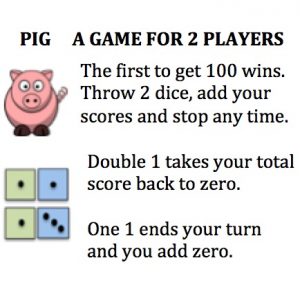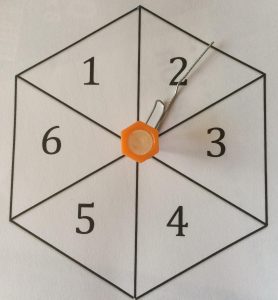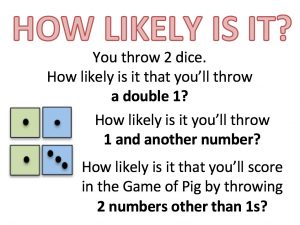Pig Games
 Both players start with zero points and take turns to throw the dice as many times as they like adding the total at each throw to their score.
Both players start with zero points and take turns to throw the dice as many times as they like adding the total at each throw to their score.
Suppose you throw a double one. On the next throw, is your chance of throwing a double one the same, more likely or less likely?
On each throw, which of the following 3 outcomes is most likely and which is least likely? How do you know?
(A) 1 and some other number
(B) A double 1
(C) Two numbers other than 1.
Can you work out a strategy so that you can win more often than you lose?
TO THE MOON AND BACK
 This is a variation of The Game of Pig in which players have to get to a score of 100 and then subtract their way back to zero. When they get to 100 this becomes a checkpoint. After that, any time they roll a double 1, they have to return to 100 and start the return journey back to zero from there.
This is a variation of The Game of Pig in which players have to get to a score of 100 and then subtract their way back to zero. When they get to 100 this becomes a checkpoint. After that, any time they roll a double 1, they have to return to 100 and start the return journey back to zero from there.
 You can make your own spinner if you don’t have dice. You will need a paper clip and a pin and will need to spin the paper clip twice for each ‘throw’. Draw a regular hexagon and write in the numbers as in the diagram or use this template.
You can make your own spinner if you don’t have dice. You will need a paper clip and a pin and will need to spin the paper clip twice for each ‘throw’. Draw a regular hexagon and write in the numbers as in the diagram or use this template.
The GAME OF PIG Inclusion and Home Learning Guide offers related learning tasks on the theme of ‘How Likely Is It?’ suitable for learners of all attainment levels and all ages from 5 to 18+.
Click here to download the GAME OF PIG Inclusion and Home Learning Guide
Click here to download the GAME OF PIG worksheet.
Click here for the AIMSSEC Notes for Teachers for years 3 to 10.
Click here for the gameboard if you want to keep score by moving your counter.
Click here to download the Game of Pig poster.
South Africa COVID-19 News
Here is the official website for COVID-19 updates.
Login
SUPPORT AIMSSEC






